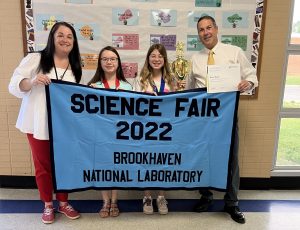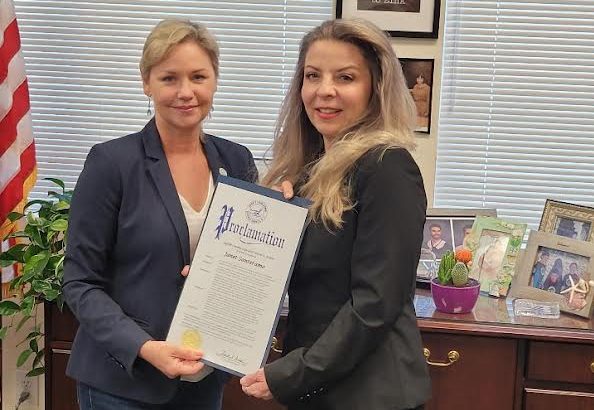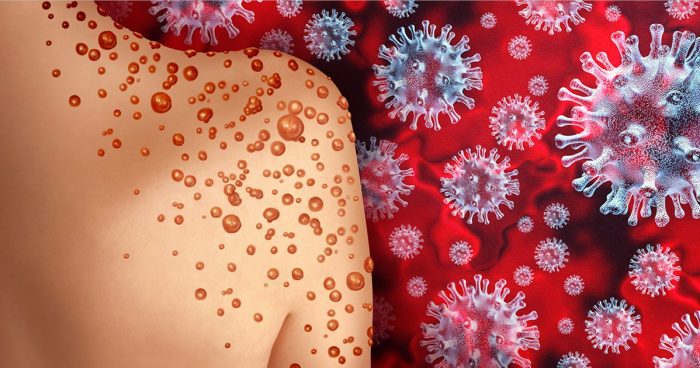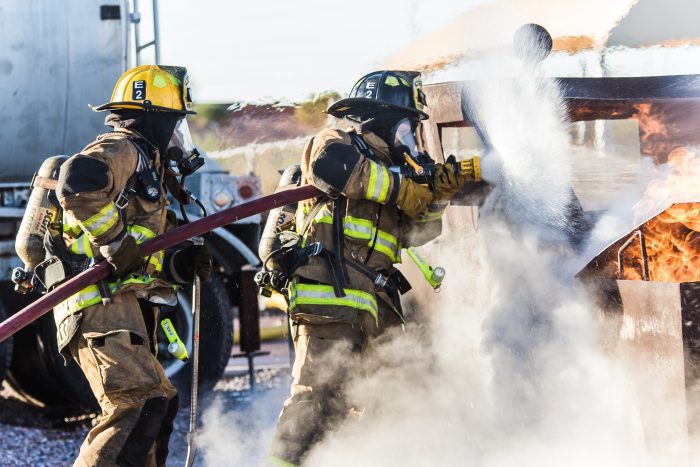Annual contest offers Long Island, NYC students an opportunity to showcase their science projects
Should you sanitize your television remote? How can we keep apple slices looking fresh? Do dogs have a favorite color? Long Island and New York City students tackled questions of all kinds using the scientific method in the 2022 Elementary School Science Fair hosted virtually by the U.S. Department of Energy’s Brookhaven National Laboratory.
The goal of the annual competition organized by the Office of Educational Programs (OEP) at Brookhaven Lab is to generate an interest in and excitement about science and engineering for all ages.
“It’s an honor and inspiration for us to look at all of the posters by students who are joining Brookhaven in a passion for discovery,” said Scott Bronson OEP manager of K-12 programs. “Just like the scientists here at Brookhaven Lab, Science Fair participants study questions of ‘how?’ and ‘why?’ to meet science challenges.”
This year’s competition invited projects by students from Suffolk County, Nassau County and New York City schools in kindergarten through sixth grade.

Participants qualified for the Brookhaven Lab contest by winning science fairs held by their schools. Volunteer judging teams consisting of elementary school teachers and Brookhaven Lab scientific and engineering staff evaluated a total of 189 projects.
“We were so excited to expand the Science Fair and welcome projects from students across all of Long Island and New York City,” said Amanda Horn, a Brookhaven Lab educator who coordinated the virtual science fair. “We loved seeing the projects from other areas and we hope to see even more projects in the future.”
The following students earned first place in their grade level and received medals and ribbons, along with banners to hang at their school to recognize the achievement:
◆ Kindergartener Rebecca Tyler of Miller Avenue Elementary School, Shoreham-Wading River School District, for her project, “How to get Permanent Marker Out of Clothes?”
◆ First grader Violet Radonis of Pines Avenue Elementary School, Hauppauge School District, for “Bad Hair Days…No More! Let’s Learn about the Land of the Rapunzals”
◆ Second grader Taran Sathish Kumar of Bretton Woods Elementary School, Hauppauge School District, for “Cleaning Up Oil Spills Using Natural Organic Sorbents”
◆ Third grader Adam Dvorkin of Pulaski Road Elementary School, Northport-East Northport School District, for “Sardine Pop in a Bathtub”
◆ Fourth grader Liam Savage of Ruth C. Kinney Elementary School, East Islip School District, for “Weight is Tow-Tally Helpful”
◆ Fifth grader Michaela Bruno of Northport Middle School, Northport-East Northport School District, for “Here Comes The Sun”
◆ Sixth grader Rebecca Bartha of Raynor Country Day School in Speonk for “Super Sea Shells Save the Seas”
Young scientists share their results
OEP staff announced the winners and honorable mentions during an online awards ceremony on June 10. Students with top-notch projects shared how they conducted their experiments.
First-grader Violet Radonis asked whether rice water can make hair grow faster and stronger. After four weeks of testing a mixture of basmati rice and water—plus orange peels for a nice scent—on eight test subjects, she found: “It does help make it a little bit better than it was before.”
Orange peels also played a part in second grader Taran Sathish Kumar’s experiment. In his search for an environmentally safe sorbent to protect marine life from oil spills, his hypothesis that orange peels would remove the most oil from water was correct. He also tested a corn cob, banana peel, and a pomegranate husk.
“Around the world when boats go in the water, oil spills from the boat and it’s harmful to the animals,” he said.
Third grader Adam Dvorkin wanted to find out what sort of pop pop (or putt putt) boat design is the fastest. He built and observed three boats, each with a different sized boiler made from a soda can bottom. The biggest boiler was the best, confirming his hypothesis.
“My favorite part was when me and my dad had to check how fast each pop pop boat was to see which one was the fastest,” he said.
Fourth grader Liam Savage tested whether adding weights to the top of a remote-control truck would increase its towing ability. He found that a specific amount of weight increased the truck’s tower power by giving it extra traction. But with too much weight, the truck would stall. With too little weight, the truck didn’t have enough grip. “My favorite part was driving my car and seeing how much weight it could pull,” he said.
Aspiring astronaut and fifth grader Michaela Bruno searched for the best material to block ultraviolet rays for protection.”I want to be an astronaut when I grow up and I want to know how the UV lights in space affect them,” she said.
By shining a UV flashlight on UV beads covered by different materials she learned that aluminon foil and dark cotton fabric offered the best protection. With those results in mind, Bruno went on to engineer a model space suit and visor.
Honorable mentions
Kindergarten: Kacey Stidd, Riverhead; Lucas Luna, Hampton Bays; John O’Donnell, Kings Park
First Grade: Hudson Costales, East Northport; Jaxon Romano, Middle Island; Marilla Pendelton, Aquebogue
Second Grade: Jude Roseto, Cutchogue; Ashleigh Bruno, Northport; Kayleigh Moore, East Northport
Third Grade: Matthew McHugh, Hauppauge; Riona Mittal, Hauppauge; Maxin Vetoshkin, Hauppauge
Fourth Grade: Evan Pereyra, Westhampton Beach; Agnes Van Winckel, Kings Park; Emma Lochner, Sayville
Fifth Grade: Mihir Sathish Kumar, Hauppauge; Faith Andria, Remsenburg; Madeline Croce, Sayville
Sixth Grade: Grace Rozell, Northport; Elle Redlinger, Montau
Brookhaven National Laboratory is supported by the Office of Science of the U.S. Department of Energy. The Office of Science is the single largest supporter of basic research in the physical sciences in the United States and is working to address some of the most pressing challenges of our time. For more information, please visit www.science.energy.gov












 Welcome to the seventh edition of Paw Prints, a monthly column for animal lovers dedicated to helping shelter pets find their furever home!
Welcome to the seventh edition of Paw Prints, a monthly column for animal lovers dedicated to helping shelter pets find their furever home!










